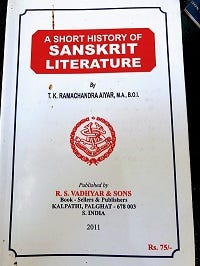Three Stage Evolution of Mahabharata - jayam, bharatam, mahabharatam
Mahabharata grew from 8000 verses to 24,000 and then to 100, 000 verses. The name also changed from jayam to bharatam to mahabharatam

There are clues in Mahabharata that tell us how the itihaas grew to become the longest poem with over a lakh verses. Mahabharata is divided into 18 parvas, with Harivamsha as the 19th. The core is around 24,000 verses about the Pandavas and Kauravas war. Besides this, there are tales of gods, kings, sages, discourses on philosophy, religion, law, and various asramas of life. We know that Vyasa was the composer who taught it to Vaisampayana, who then narrated it to Janamejaya at his sarpa yagna. Ugrasravas, the suta, then narrated it to others at Namisharanyam. Recently, I read a book --- A Short History of Sanskrit Literature --- which elaborates on a theory on how Mahabaharatam came to be.
Here are three verses from Mahabharatam which refers to three different lengths
This verse refers to the first stage, which has over 8000 verses.
This is a reference to the 24,000 verses.
This refers to the third stage with over a lakh verses.
It is not just that the number of verses increased; the name of the itihaas also changed. The very first line in adi parvam refers to it as jayam.
नारायणं नमस्कृत्य नरं चैव नरॊत्तमम
देवीं सरस्वतीं चैव ततॊ जयम उदीरयेत
Then it became bharatam and finally, Mahabharatam. Was it because it passed through three people --- Vyasa, Vaisampayana, and Ugrasravas?
The author of the book, T. K. Ramachandra Aiyar, thinks that the core of Mahabharata is the rivalry of Kurus and Panchalas. Their animosity is historic. They quarreled for a long time, and finally, there was a union. The Yajurveda --- which was composed in a nearby region --- mentions this. The Kathaka Samhita, though, speaks of a dispute between Vaka Dalbhya from Panchala and a Dritharashtra, the son of a Vichitravirya, a Kuru. Over time, the kingdoms split again and engaged in constant rivalry. By the time of Mahabharata, the Kuru and Panchala kingdoms were separate.
Before the war, a turn of events caused the annexation of Northern Panchala by the Kurus. This is the incident where Drona defeats Drupada using Arjuna. This event upset the balance of power between the two kingdoms. The Kurus were defeated in the war, and the Panchalas won along with the Pandavas. (Here is an interesting explanation about the Mahabharata war, not as a rivalry between Kauravas and Pandavas, but as a war between Kurus and Panchalas).
With this background, here is the theory on what might have happened. The defeat of the Kurus would have resulted in various songs glorifying the victory of the Pandavas and their allies. Sutas would have sung this in various assemblies. This would have been Jayam. By the second stage, when it reaches 24,000 verses, the life of Pandavas is elaborated. Krishna was represented as an incarnation of Vishnu, and Shiva and Vishnu became more prominent than Brahma. The epic became famous all over bharatavarsha, and other additions like the stories of gods and sages were added, and it became a treatise on dharmashastra. This was the third stage.
The book became an authority on dharma dealing with religion, law, and morality. It was accorded the status of the 5th veda. Land grants dating between 462 CE and 532 CE talk about the one-lakh verse Mahabharatam compiled by Vyasa. There is a lot of literary evidence from Sanskrit authors on the stature of Mahabharata. From Ujjayini to Khamboja, the ithihaas were read in temples. It became a national epic.







great information. thank you